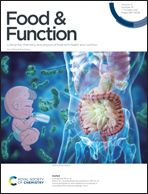Development of natural pigments microencapsulated in waste yeast Saccharomyces cerevisiae using spray drying technology and their application in yogurt
Abstract
Although Saccharomyces cerevisiae has shown potential utilization as a bio-vehicle for encapsulation, there are no reports about the functionality of natural colorants encapsulated using yeast cells. The main objectives of this study were to produce natural food coloring by encapsulating extracts from grape pomace (GP) and jabuticaba byproducts (JB) in brewery waste yeast and evaluate the functionality of the pigments by their incorporation into yogurts. Particles produced by the encapsulation of extracts from GP and JB in S. cerevisiae using 5% of yeast had the highest encapsulation efficiencies for both anthocyanins (11.1 and 47.3%) and phenolic compounds (67.5 and 63.6%), the highest concentration of both bioactives during storage and stable luminosity. Yogurts showed a pseudoplastic behavior and were considered weak gels. Colored yogurts had acceptance indexes between 73.9 and 81.4%. This work evidenced the utilization of enriched yeasts as coloring agents and interesting additives for the production of functional foods.



 Please wait while we load your content...
Please wait while we load your content...